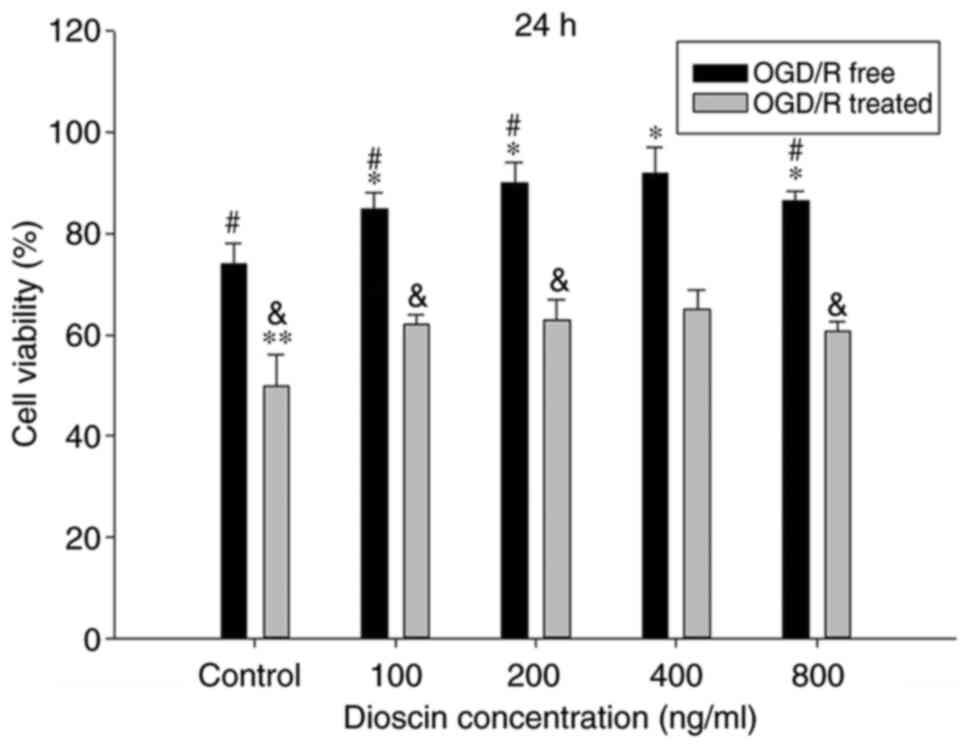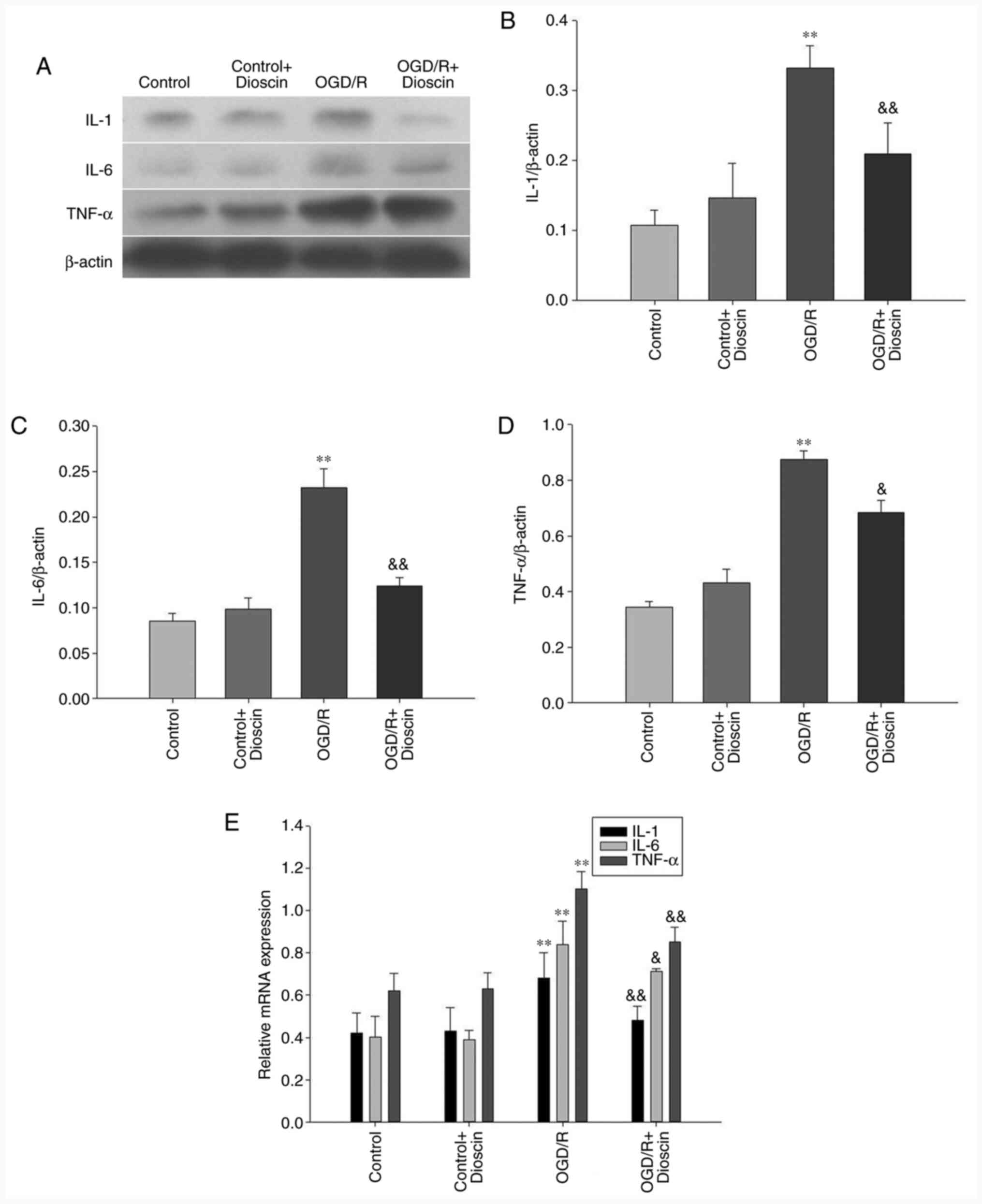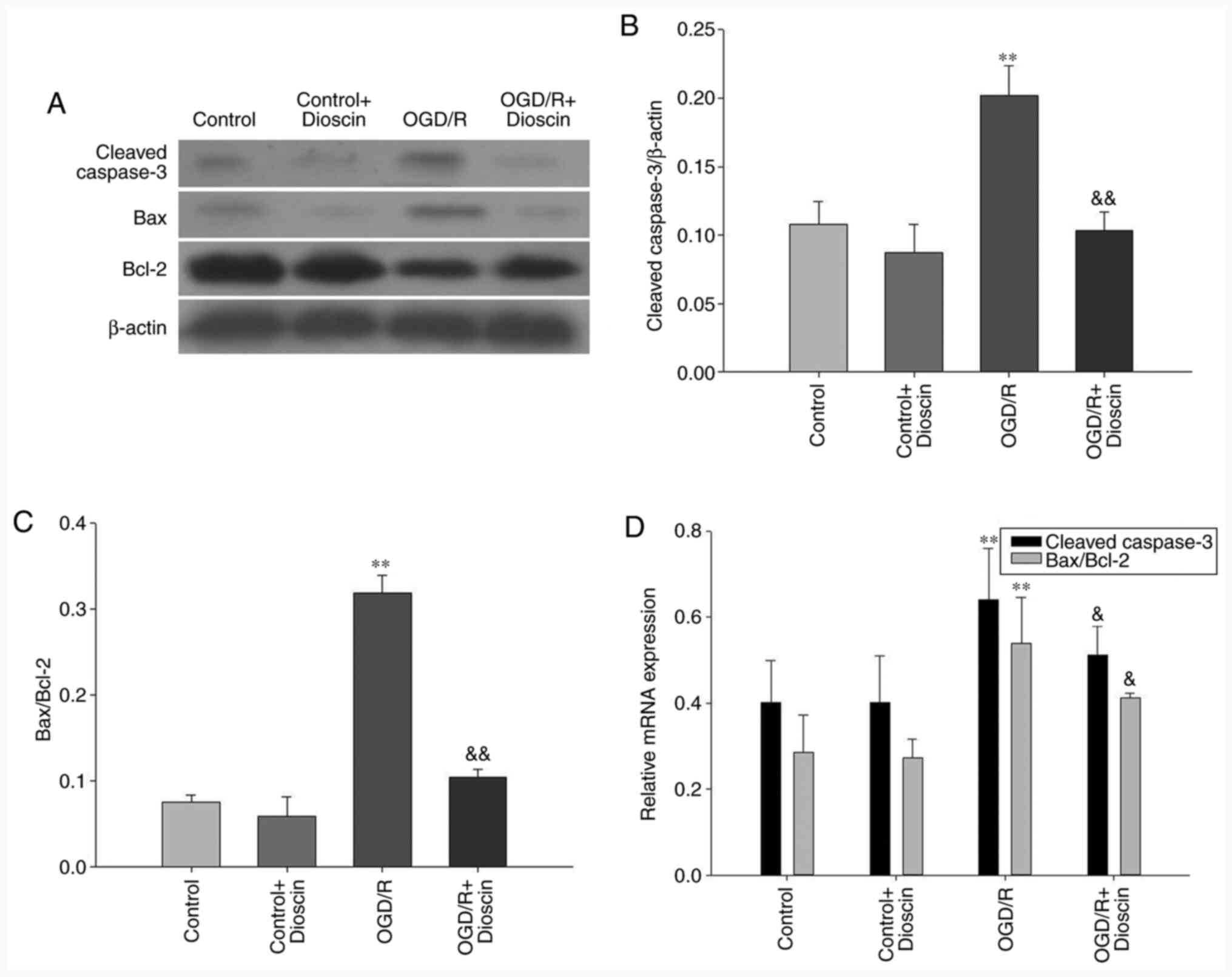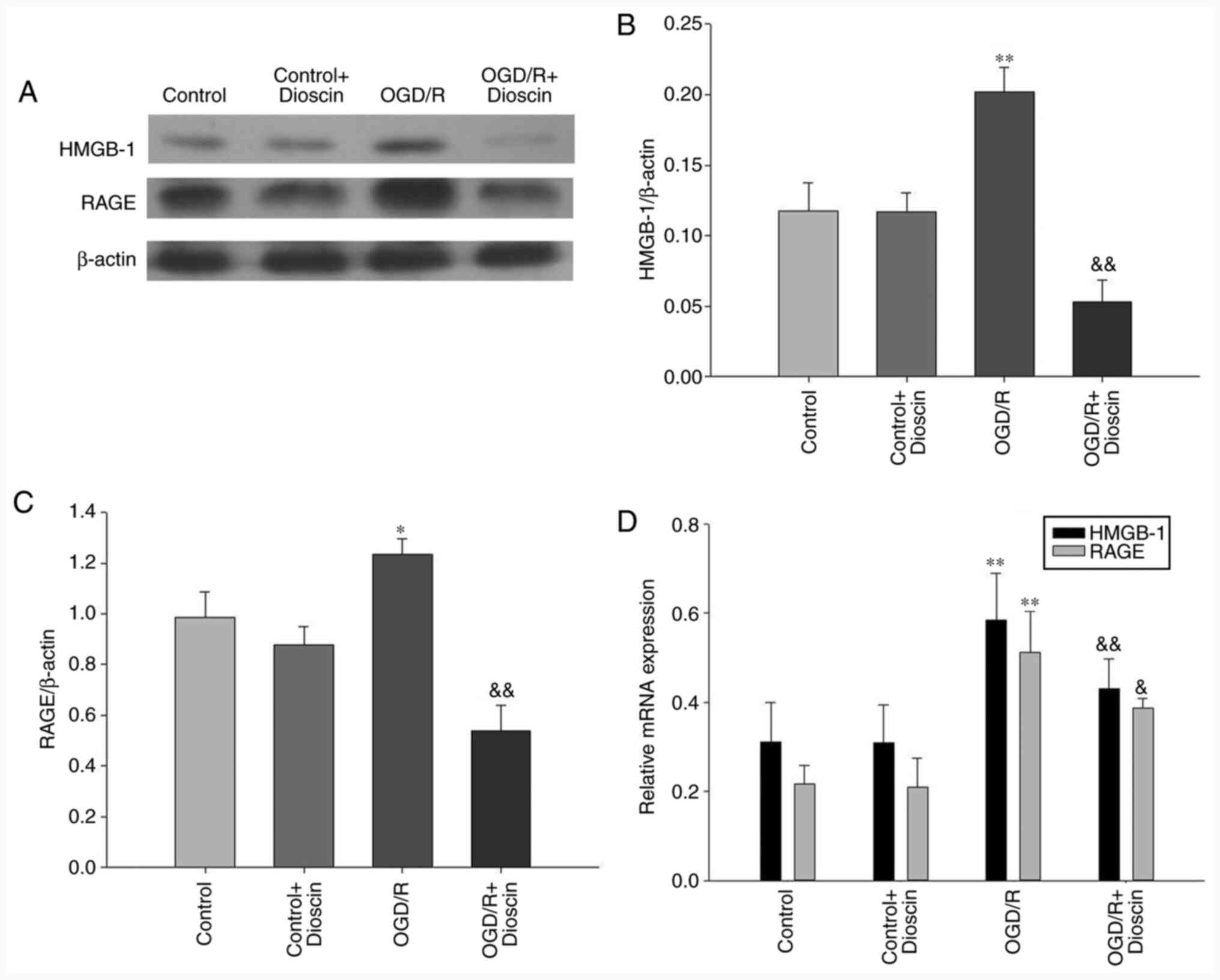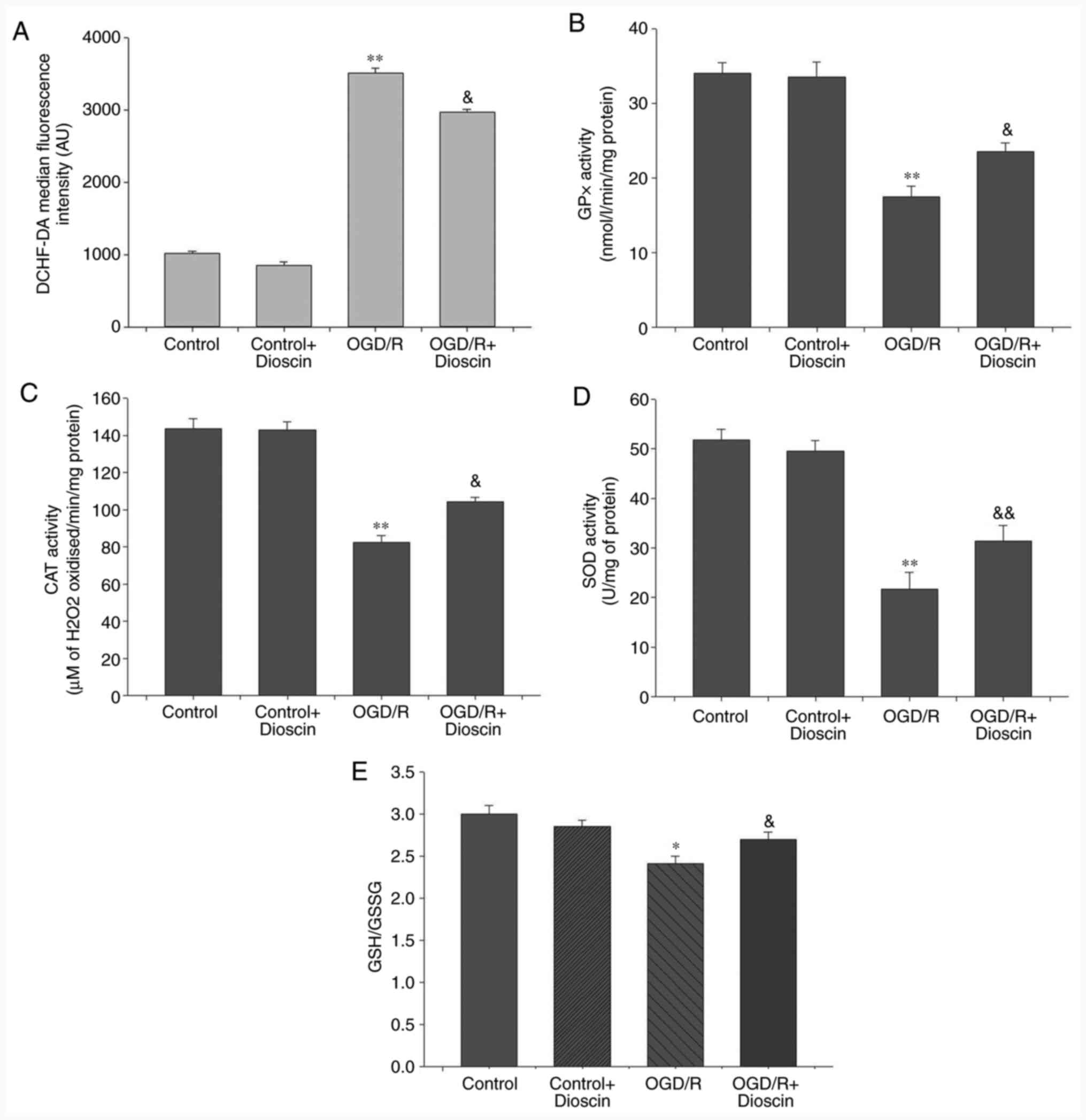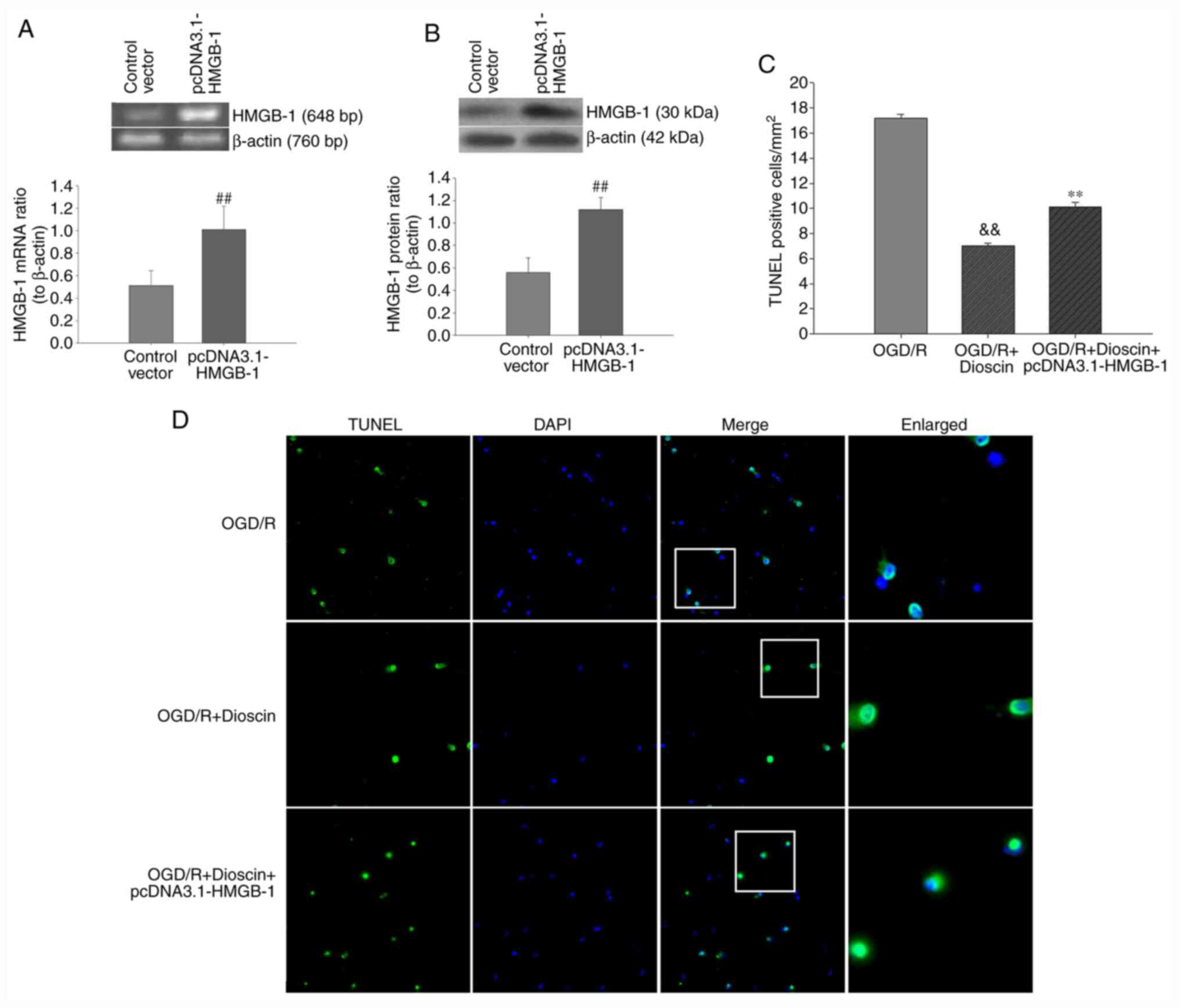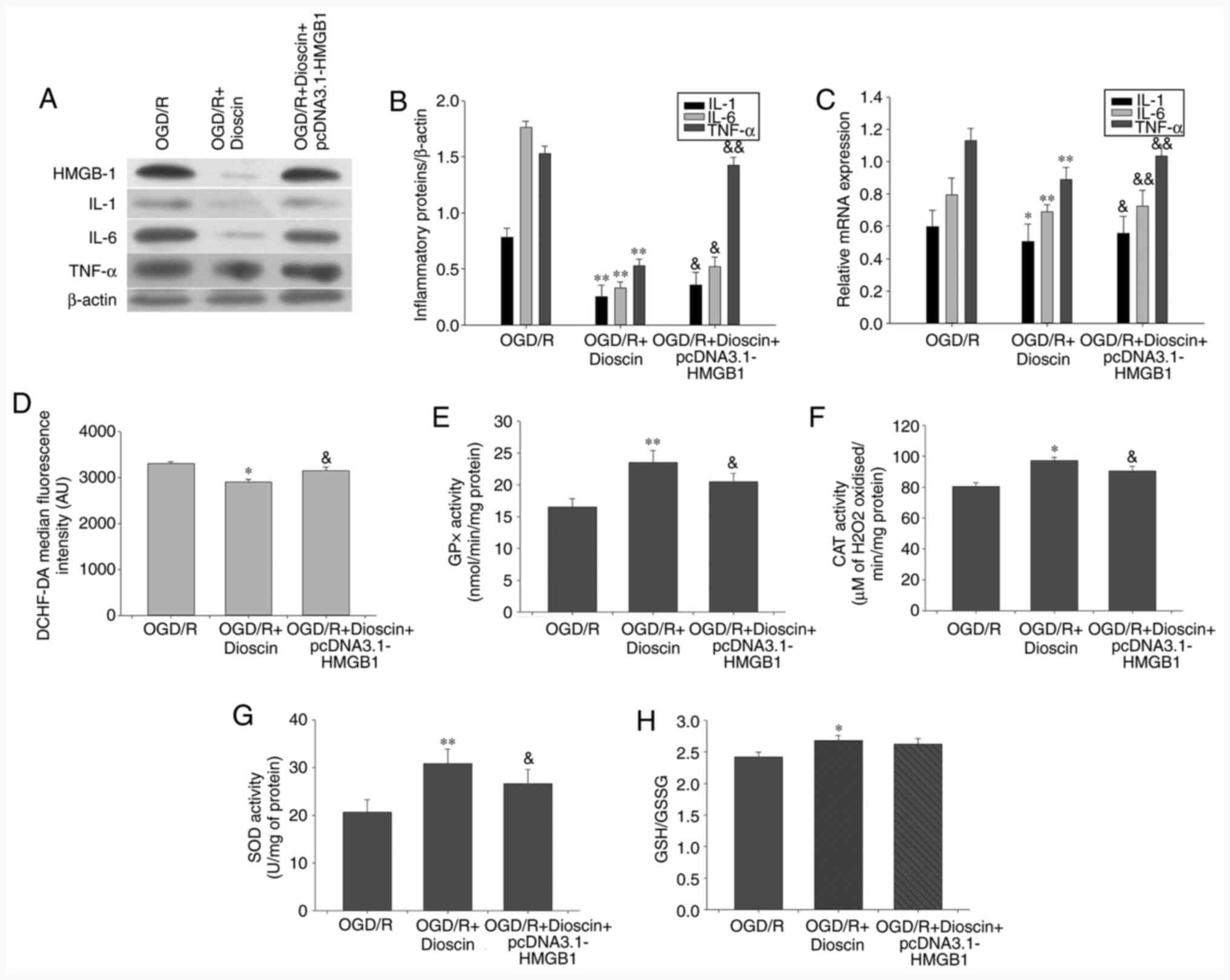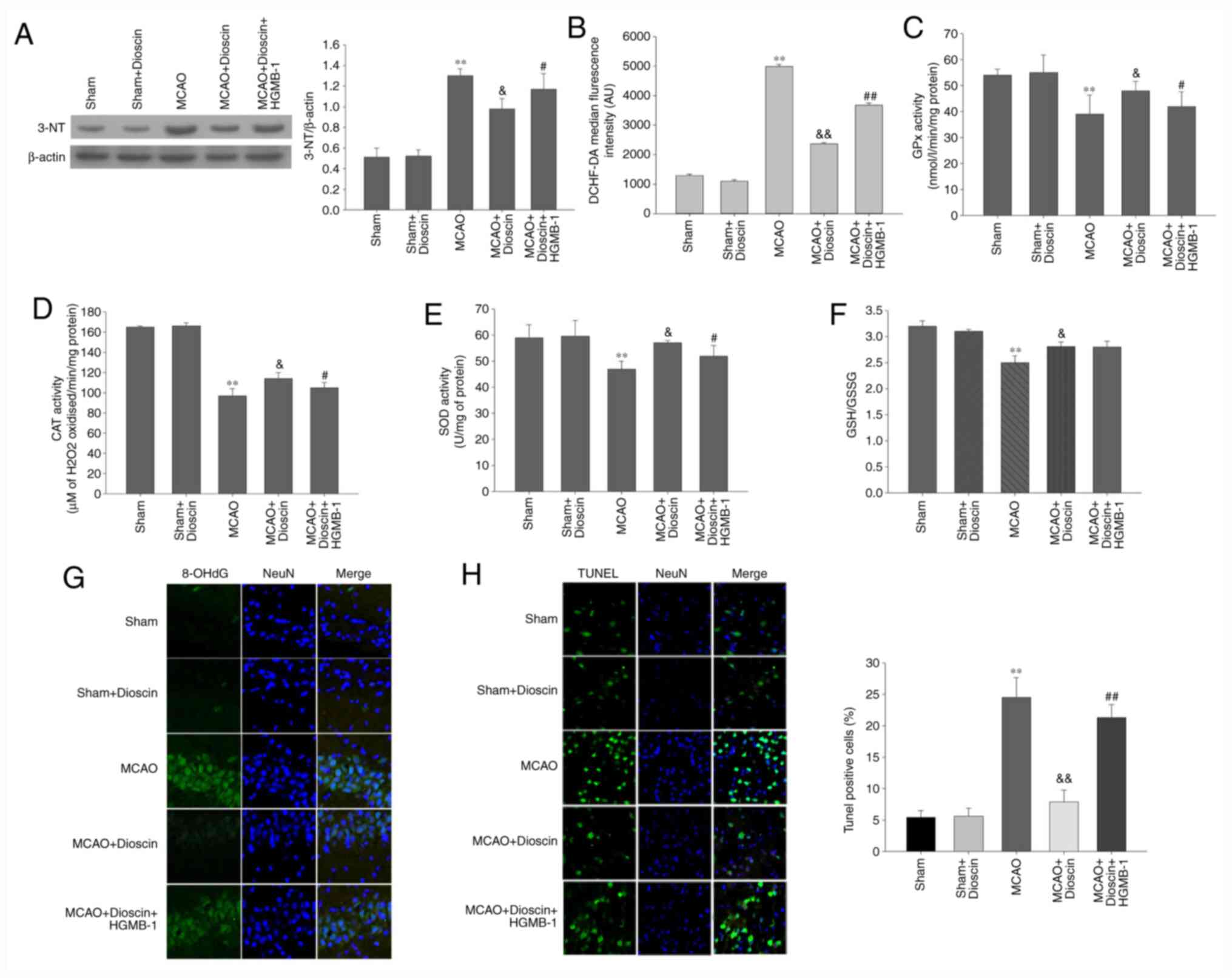|
1
|
Feigin V, Roth G, Naghavi M, Parmar P,
Krishnamurthi R, Chugh S, Mensah GA, Norrving B, Shiue I, Ng M, et
al: Global burden of stroke and risk factors in 188 countries,
during 1990-2013: A systematic analysis for the Global Burden of
Disease Study 2013. Lancet Neurol. 15:913–924. 2016.PubMed/NCBI View Article : Google Scholar
|
|
2
|
Candelario-Jalil E: Injury and repair
mechanisms in ischemic stroke: Considerations for the development
of novel neurotherapeutics. Curr Opin Investig Drugs. 10:644–654.
2009.PubMed/NCBI
|
|
3
|
Stoll G, Kleinschnitz C and Nieswandt B:
Combating innate inflammation: A new paradigm for acute treatment
of stroke? Ann N Y Acad Sci. 1207:149–154. 2010.PubMed/NCBI View Article : Google Scholar
|
|
4
|
Scaffidi P, Misteli T and Bianchi ME:
Release of chromatin protein HMGB1 by necrotic cells triggers
inflammation. Nature. 418:191–195. 2002.PubMed/NCBI View Article : Google Scholar
|
|
5
|
Zhang Z, Wu Y, Zhao Y, Xiao X, Liu J and
Zhou X: Dynamic changes in HMGB1 levels correlate with inflammatory
responses during cardiopulmonary bypass. Exp Ther Med. 5:1523–1527.
2013.PubMed/NCBI View Article : Google Scholar
|
|
6
|
Tsung A, Sahai R, Tanaka H, Nakao A, Fink
MP, Lotze MT, Yang H, Li J, Tracey KJ, Geller DA and Billiar TR:
The nuclear factor HMGB1 mediates hepatic injury after murine liver
ischemia-reperfusion. J Exp Med. 201:1135–1143. 2005.PubMed/NCBI View Article : Google Scholar
|
|
7
|
Xie J, Méndez J D, Méndez-Valenzuela V and
Aguilar-Hernández MM: Cellular signalling of the receptor for
advanced glycation end products (RAGE). Cell Signal. 25:2185–2197.
2013.PubMed/NCBI View Article : Google Scholar
|
|
8
|
Zhang F, Su X, Huang G, Xin XF, Cao EH,
Shi Y and Song Y: sRAGE alleviates neutrophilic asthma by blocking
HMGB1/RAGE signalling in airway dendritic cells. Sci Rep.
7(14268)2017.PubMed/NCBI View Article : Google Scholar
|
|
9
|
Jang HJ, Han IH, Kim YJ, Yamabe N, Lee D,
Hwang GS, Oh M, Choi KC, Kim SN, Ham J, et al: Anticarcinogenic
effects of products of heat-processed ginsenoside Re, a major
constituent of ginseng berry, on human gastric cancer cells. J
Agric Food Chem. 62:2830–2836. 2014.PubMed/NCBI View Article : Google Scholar
|
|
10
|
Zhao X, Tao X, Xu L, Yin L, Qi Y, Xu Y,
Han X and Peng J: Dioscin induces apoptosis in human cervical
carcinoma HeLa and SiHa cells through ROS-mediated DNA damage and
the mitochondrial signaling pathway. Molecules.
21(730)2016.PubMed/NCBI View Article : Google Scholar
|
|
11
|
Zhang Y, Xu Y, Qi Y, Xu L, Song S, Yin L,
Tao X, Zhen Y, Han X, Ma X, et al: Protective effects of dioscin
against doxorubicin-induced nephrotoxicity via adjusting
FXR-mediated oxidative stress and inflammation. Toxicology.
378:53–64. 2017.PubMed/NCBI View Article : Google Scholar
|
|
12
|
Ikeda T, Ando J, Miyazono A, Zhu XH,
Tsumagari H, Nohara T, Yokomizo K and Uyeda M: Anti-herpes virus
activity of Solanum steroidal glycosides. Biol Pharm Bull.
23:363–364. 2000.PubMed/NCBI View Article : Google Scholar
|
|
13
|
Yang Q, Wang C, Jin Y, Ma X, Xie T, Wang
J, Liu K and Sun H: Disocin prevents postmenopausal atherosclerosis
in ovariectomized LDLR-/-mice through a PGC-1α/ERα pathway leading
to promotion of autophagy and inhibition of oxidative stress,
inflammation and apoptosis. Pharmacol Res.
148(104414)2019.PubMed/NCBI View Article : Google Scholar
|
|
14
|
Lu B, Yin L, Xu L and Peng J: Application
of proteomic and bioinformatic techniques for studying the
hepatoprotective effect of dioscin against CCl4-induced liver
damage in mice. Planta Med. 77:407–415. 2011.PubMed/NCBI View Article : Google Scholar
|
|
15
|
Lu J, Zhang T, Sun H, Wang S and Liu M:
Protective effects of dioscin against cartilage destruction in a
monosodium iodoacetate (MIA)-indcued osteoarthritis rat model.
Biomed Pharmacother. 108:1029–1038. 2018.PubMed/NCBI View Article : Google Scholar
|
|
16
|
Dias KL, Correia Nde A, Pereira KK,
Barbosa-Filho JM, Cavalcante KV, Araújo IG, Silva DF, Guedes DN,
Neto Mdos A, Bendhack LM and Medeiros IA: Mechanisms involved in
the vasodilator effect induced by diosgenin in rat superior
mesenteric artery. Eur J Pharmacol. 574:172–178. 2007.PubMed/NCBI View Article : Google Scholar
|
|
17
|
Lee BK, Kim CJ, Shin MS and Cho YS:
Diosgenin improves functional recovery from sciatic crushed nerve
injury in rats. J Exerc Rehabil. 14:566–572. 2018.PubMed/NCBI View Article : Google Scholar
|
|
18
|
Gong G, Qin Y and Huang W: Anti-thrombosis
effect of diosgenin extract from Dioscorea zingiberensis CH
Wright in vitro and in vivo. Phytomedicine. 18:458–463.
2011.PubMed/NCBI View Article : Google Scholar
|
|
19
|
Zheng H, Wei Z, Xin G, Ji C, Wen L, Xia Q,
Niu H and Huang W: Preventive effect of a novel diosgenin
derivative on arterial and venous thrombosis in vivo. Bioorg Med
Chem Lett. 26:3364–3369. 2016.PubMed/NCBI View Article : Google Scholar
|
|
20
|
Liu J, Pasini S, Shelanski ML and Greene
LA: Activating transcription factor 4 (ATF4) modulates
post-synaptic development and dendritic spine morphology. Front
Cell Neurosci. 8(177)2014.PubMed/NCBI View Article : Google Scholar
|
|
21
|
National Research Council (US) Institute
for Laboratory Animal Research: Guide for the Care and Use of
Laboratory Animals. National Academies Press, Washington, DC, 1996.
urihttps://www.ncbi.nlm.nih.gov/books/NBK232589/simplehttps://www.ncbi.nlm.nih.gov/books/NBK232589/
doi: 10.17226/5140.
|
|
22
|
Xiong Y, Xia Y, Deng J, Yan X, Ke J, Zhan
J, Zhang Z and Wang Y: Direct peritoneal resuscitation with
pyruvate protects the spinal cord and induces autophagy via
regulating PHD2 in a rat model of spinal cord ischemia-reperfusion
injury. Oxid Med Cell Longev. 2020(4909103)2020.PubMed/NCBI View Article : Google Scholar
|
|
23
|
Livak KJ and Schmittgen TD: Analysis of
relative gene expression data using real-time quantitative PCR and
the 2(-Delta Delta C(T)) method. Methods. 25:402–408.
2001.PubMed/NCBI View Article : Google Scholar
|
|
24
|
Hissin PJ and Hilf R: A fluorometric
method for determination of oxidized and reduced glutathione in
tissues. Anal Biochem. 74:214–226. 1976.PubMed/NCBI View Article : Google Scholar
|
|
25
|
Flohé L and Günzler WA: Assays of
glutathione peroxidase. Methods Enzymol. 105:114–121.
1984.PubMed/NCBI View Article : Google Scholar
|
|
26
|
Aebi H: Catalase in vitro. Methods
Enzymol. 105:121–126. 1984.PubMed/NCBI View Article : Google Scholar
|
|
27
|
Hassan MQ, Akhtar MS, Akhtar M, Ansari SH,
Ali J, Haque SE and Najmi AK: Benidipine prevents oxidative stress,
inflammatory changes and apoptosis related myofibril damage in
isoproterenol-induced myocardial infarction in rats. Toxicol Mech
Methods. 25:26–33. 2015.PubMed/NCBI View Article : Google Scholar
|
|
28
|
Hankey GJ: Stroke. Lancet. 389:641–654.
2017.PubMed/NCBI View Article : Google Scholar
|
|
29
|
Onwuekwe IO and Ezeala-Adikaibe B:
Ischemic stroke and neuroprotection. Ann Med Health Sci Res.
2:186–190. 2012.PubMed/NCBI View Article : Google Scholar
|
|
30
|
Cuzzocrea S, Riley DP, Caputi AP and
Salvemini D: Antioxidant therapy: A new pharmacological approach in
shock, inflammation, and ischemia/reperfusion injury. Pharmacol
Rev. 53:135–159. 2001.PubMed/NCBI
|
|
31
|
Tao X, Yin L, Xu L and Peng J: Dioscin: A
diverse acting natural compound with therapeutic potential in
metabolic diseases, cancer, inflammation and infections. Pharmacol
Res. 137:259–269. 2018.PubMed/NCBI View Article : Google Scholar
|
|
32
|
Yin W, Liu S, Dong M, Liu Q, Shi C, Bai H,
Wang Q, Yang X, Niu W and Wang L: A new NLRP3 inflammasome
inhibitor, Dioscin, promotes osteogenesis. Small.
16(e1905977)2020.PubMed/NCBI View Article : Google Scholar
|
|
33
|
Qi M, Zheng L, Qi Y, Han X, Xu Y, Xu L,
Yin L, Wang C, Zhao Y, Sun H, et al: Dioscin attenuates renal
ischemia/reperfusion injury by inhibiting the TLR4/MyD88 signaling
pathway via up-regulation of HSP70. Pharmacol Res. 100:341–352.
2015.PubMed/NCBI View Article : Google Scholar
|
|
34
|
Tao X, Sun X, Yin L, Han X, Xu L, Qi Y, Xu
Y, Li H, Lin Y, Liu K and Peng J: Dioscin ameliorates cerebral
ischemia/reperfusion injury through the downregulation of TLR4
signaling via HMGB-1 inhibition. Free Radic Biol Med. 84:103–115.
2015.PubMed/NCBI View Article : Google Scholar
|
|
35
|
Tao X, Wan X, Xu Y, Xu L, Qi Y, Yin L, Han
X, Lin Y and Peng J: Dioscin attenuates hepatic
ischemia-reperfusion injury in rats through inhibition of
oxidative-nitrative stress, inflammation and apoptosis.
Transplantation. 98:604–611. 2014.PubMed/NCBI View Article : Google Scholar
|
|
36
|
Zhang G, Zeng X, Zhang R, Liu J, Zhang W,
Zhao Y, Zhang X, Wu Z, Tan Y, Wu Y and Du B: Dioscin suppresses
hepatocellular carcinoma tumor growth by inducing apoptosis and
regulation of TP53, BAX, BCL2 and cleaved CASP3. Phytomedicine.
23:1329–1336. 2016.PubMed/NCBI View Article : Google Scholar
|
|
37
|
Yao H, Hu C, Yin L, Tao X, Xu L, Qi Y, Han
X, Xu Y, Zhao Y, Wang C and Peng J: Dioscin reduces
lipopolysaccharide-induced inflammatory liver injury via regulating
TLR4/MyD88 signal pathway. Int Immunopharmacol. 36:132–141.
2016.PubMed/NCBI View Article : Google Scholar
|
|
38
|
Zhang W, Yin L, Tao X, Xu L, Zheng L, Han
X, Xu Y, Wang C and Peng J: Dioscin alleviates
dimethylnitrosamine-induced acute liver injury through regulating
apoptosis, oxidative stress and inflammation. Environ Toxicol
Pharmacol. 45:193–201. 2016.PubMed/NCBI View Article : Google Scholar
|
|
39
|
Zhu S, Tang S and Su F: Dioscin inhibits
ischemic stroke-induced inflammation through inhibition of the
TLR4/MyD88/NF-κB signaling pathway in a rat model. Mol Med Rep.
17:660–666. 2018.PubMed/NCBI View Article : Google Scholar
|
|
40
|
Liu A, Dirsch O, Fang H, Sun J, Jin H,
Dong W and Dahmen U: HMGB1 in ischemic and non-ischemic liver after
selective warm ischemia/reperfusion in rat. Histochem Cell Biol.
135:443–452. 2011.PubMed/NCBI View Article : Google Scholar
|
|
41
|
Bortolotto V and Grilli M: Every cloud has
a silver lining: Proneurogenic effects of Aβ oligomers and HMGB-1
via activation of the RAGE-NF-κB axis. CNS Neurol Disord Drug
Targets. 16:1066–1079. 2017.PubMed/NCBI View Article : Google Scholar
|















